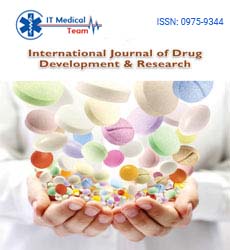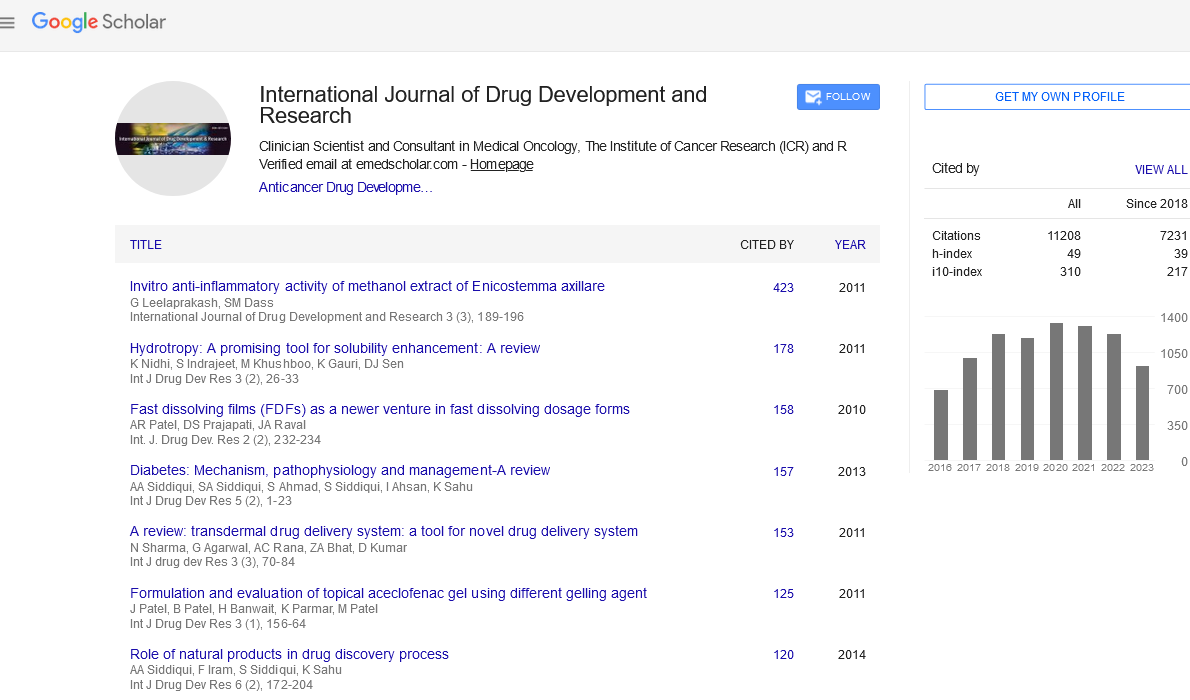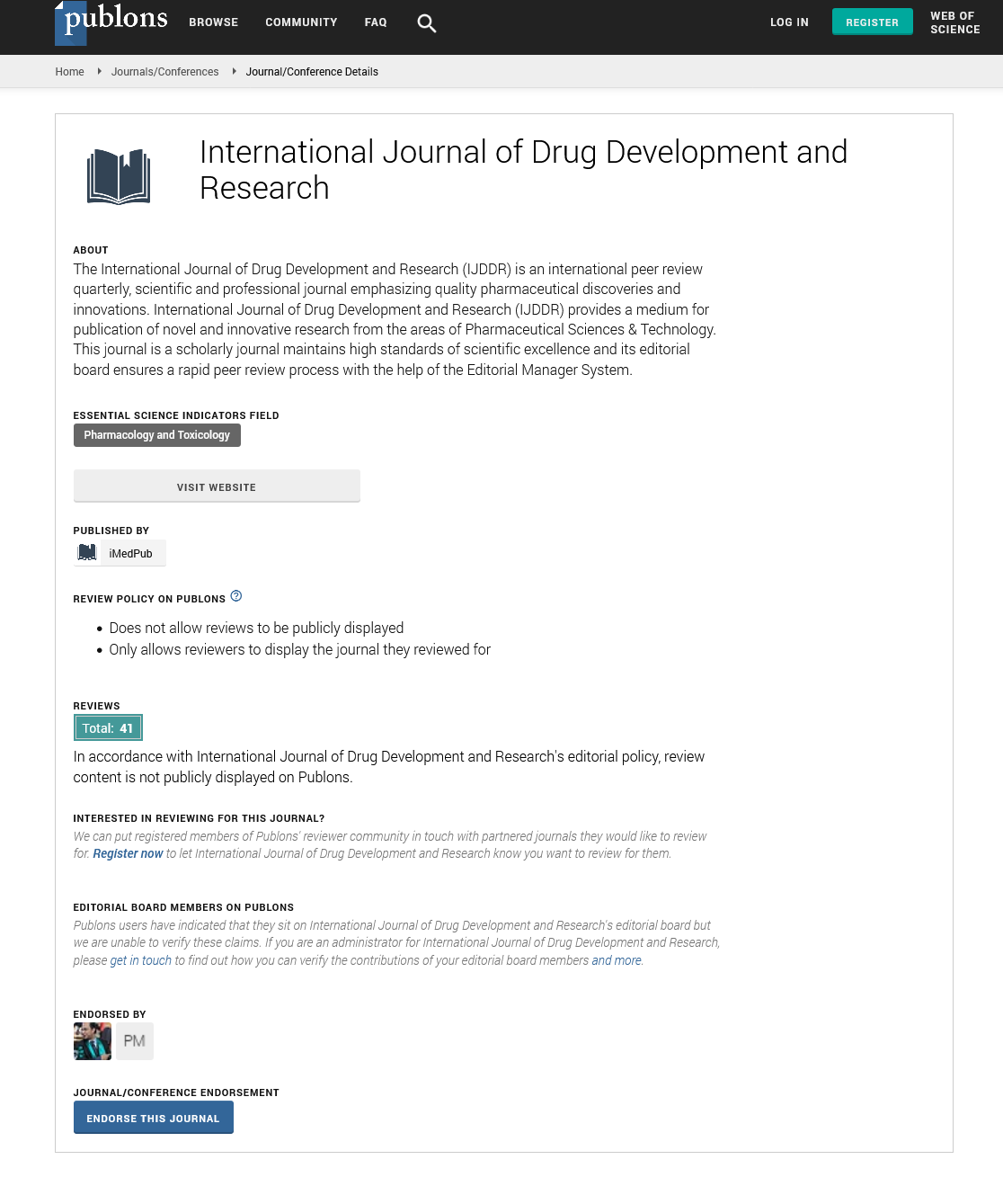Key words
|
| |
| Spathodea campanulata, superoxide and nitric oxide radical scavenging activity. |
| |
INTRODUCTION
|
| |
| Many of the deseases are mainly linked to oxidative stress due to free radicals [1]. Free radicals are reactive species generated in the body during normal metabolic functions. These species causes cellular damage by reacting with the various bio molecules of body such as membrane lipids, nucleic acid, proteins and enzymes. This damage is the major contributor of many disorders like Cancer, Hepatopathy, Cardiovascular diseases, Inflammation, Diabetes mellitus, renal failure and Brain dysfunction [2]. The most common reactive oxygen species (ROS) includes superoxide anion (O. 2), hydrogen peroxide (H2O2), peroxyl radicals (ROO) and reactive hydroxyl (OH.) radicals. RNS includes nitric oxide (NO) and peroxy nitrite anion (ONOO) [3]. Body has itself antioxidant system which reacts species and neutralizes them [4]. |
| |
| Many medicinal plants contain substantial amounts of antioxidants other than vitamin C, Vit-E and carotenoids . Anioxidants have been reported to prevent oxidative damage caused by free radical and may prevent the occurrence of disease, cancer and aging. It can interfere with the the oxidation process by reacting with free radicals, chelating, catalytic metals and also by acting as oxygen scavengers [5] and thus can be utilized to scavenge the excessive free radicals generated from human body [6]. Therefore, in the recent years, the antioxidants are derived from herbal medicine in view of their medicinal benefits. The medicinal properties of plants have been investigated in the recent scientific developments throught the world, due to their potent antioxidant activities, no side effects and economic viability [5]. Flavonoids and phenolic compounds are widely distributed in plants which have been reported to exert multiple biological effects, including antioxidant, free radical scavenging abilities, anti-inflammatory, anticarcinogenic etc [7]. In this view, we have selected one of such herb called as Spathodea campanulata. |
| |
| Spathodea campanulata P. Beauv species belonging to the Bignoniaceae family. In Kannada it is commonly called as Uchhe kaayi. Bark contains sterols, triterpenoids, tranorin, vannillic acid, ferulic acid, verminoside, pelargonidin diglycoside, maldivin, tannin. Leaves contain polyhydroxy sterol spathodol, quercetin, chlorogenic acid [8]. This species has many uses in folk medicine such as, the flowers are employed as diuretic and antiinflammatory, while the leaves are used against kidney diseases, urethra inflammations and as an antidote against animal poisons. The stem bark preparations are employed against enemas, fungus skin diseases, herpes, stomachaches and diarrhea [9]. The leaves have furnished spathodol, caffeic acid, other phenolic acids and flavonoids [10,11,12]. |
| |
| Several medicinal property have been reported, including Flavonoids of eight bignoniaceous plants [13], Leaf has been reported to possess antiplasmodial activity[14], analgesic and anti-inflammatory properties[15], Hypoglycemic, anti-HIV and antimalarial activity were also observed in stem bark extracts [16,17]. The literature survey revealed that so far no scientific studies carried out on its in vitro antioxidant activity of the ethanol extract of leaves of Spathodea campanulata. Hence, in the present study, we focused to evaluate the in vitro antioxidant activity and free radical scavenging activity of the ethanol extract of Spathodea campanulata leaves. |
| |
MATERIAL AND METHODS
|
| |
|
Plant material & Extraction
|
| |
| The fresh leaves of Spathodea campanulata were collected from B.G. Nagar, Mandya (District), Karnataka, India. The air dried leaves of Spathodea campanulata coarsely powdered and extracted with ethanol in a Soxhlet extractor for 18-20 hours and solution was evaporated to dryness under reduced pressure and controlled temperature by using rota-evaporator. The extract was stored in a refrigerator at 4°C until further use. The extract was subjected for preliminary qualitative phytochemical studies. |
| |
|
Phytochemical Analysis
|
| |
| Phytochemical studies of ethanol extract of S. campanulata leaves showed the presence of alkaloids, saponins, steroid, anthraquinone glycosides, flavonoids, triterpenoids and tannins [18]. |
| |
|
Antioxidant Activity
|
| |
| In all methods, extract concentration ranging from 25 - 500 ìg/ml concentration was taken with appropriate standards and checked for the antioxidant activity in different models. Absorbance was measured against blank solutions that contain extract or standard, but without the reagents. A control was performed without adding extracts or standards. Percentage scavenging and IC50 values ± S.D were calculated. |
| |
|
Nitric Oxide Scavenging Activity
|
| |
| Nitric oxide scavenging activity was measured by the spectrophotometric method [19]. Sodium nitroprusside (5 mM) in phosphate-buffer saline (10 mM) was mixed with a control without the test compound, but with an equivalent amount of methanol. Test solutions at different concentrations (25-500 µg/ml) were dissolved in methanol and incubated at 25°C for 30 minutes. After 30 minutes, to 1.5 ml of the incubated solution was diluted with 1.5 ml of Griess reagent (1% sulphanilamide, 2% phosphoric acid and 0.1% naphthyl ethylenediamine dichloride). The absorbance of the chromophore formed during the diazotization of the nitrile with sulphanilamide and the subsequent coupling with naphthyethylene diamine dihydrochloride was measured at 546 nm. Curcumin was taken as standard antioxidant. |
| |
|
Superoxide Scavenging Activity
|
| |
| Superoxide scavenging was carried out using the alkaline dimethyl sulfoxide (DMSO) method [20]. Solid potassium superoxide was allowed to stand in contact with dry DMSO for at least 24 hours and the solution was filtered immediately before use; the filtrate (200 µl) was added to 2.8 ml of an aqueous solution containing nitroblue tetrazolium (56 µM), EDTA (10 µM) and potassium phosphate buffer (10 µM, pH 7.4). Test solutions at different concentrations (25-500 µg/mL) were added and absorbances were recorded at 560 nm against the control. Ascorbic acid was taken as standard antioxidant. |
| |
|
Evaluation Of Antioxidant Capacity By Phosphomolybdenum Method
|
| |
| The total antioxidant capacity of test sample and α-tocopherol were evaluated according to the method described by Prieto [21]. An aliquot of 0.1 mL of sample solution and α-tocopherol (0-500 µg/mL) was combined with 1 mL of reagent solution (0.6 M sulfuric acid, 28 mM sodium phosphate and 4 mM ammonium molybdate). In case of blank, 0.1 mL of ethanol was used in place of sample. The tubes were incubated in a boiling water bath at 95oC for 90 minutes. After the samples were cooled to room temperature, the absorbance of the aqueous solution of each was measured at 695 nm against blank in spectrophotometer. Antioxidant capacity was expressed as equivalents of α- tocopherol. |
| |
|
Statistical Analysis
|
| |
| Linear regression analysis was used to calculate the IC50 values of the extracts. |
| |
RESULTS
|
| |
| Nitric oxide scavenging activity was assessed by Sodium nitroprisside method. It was checked in the range of 25–500 µg/mL concentration of S. campanulata. Maximum inhibition was about 81% (Figure 1). IC50 value of S. campanulata extract was 160 µg/mL (Table 1). Standard Curcumin showed 79 % inhibition at 15 µg concentration. |
| |
| In alkaline DMSO method, S. campanulata showed a good superoxide scavenging activity with 79% of inhibition at 500 µg/mL (Figure 2). IC50 value of S. campanulata ethanolic extract was 198 µg/mL (Table 1). Standard Ascorbic acid showed 90% inhibition at 100 µM concentration. |
| |
| Total antioxidant activity was compared to the concentration of α-Tocopherol. S. campanulata extract was checked in 50 and 500 µg/mL concentration which showed 0.052 and 0.355 OD at 695 nm, where as standards showed 0.178 OD at 100 µg/mL. 50 and 100 µg/mL of S. campanulata extract was equivalent to 29.2 and 199.4 µg/mL of α-Tocopherol (Figure 3). |
| |
DISCUSSION
|
| |
| Reactive oxygen species (ROS) such as superoxide radicals, hydroxyl radicals, iron-oxygen complexas, hydrogen peroxide and lipid peroxides are generated by several oxidatives reactions [22]. Therefore, excessive ROS can also react with biological molecules such as DNA, proteins and phopholipids and cause oxidative damage in tissue [23]. An imbalance between the amount of ROS and antioxidant enzymes is a problem for our health. Hence, the daily intake of foods with antioxidant is necessary [24, 25]. |
| |
| Free radical is a molecule with an unpaired electron and is involved in bacterial and parasitic infections, lung damage, inflammation, cardiovascular disorders, atherosclerosis, autoimmune disorders, aging and neoplastic diseases. Antioxidant compounds may function as free radical scavengers, initiator of the complexes of pro-oxidant metals, reducing agents and quenchers of singlet oxygen formation. Phenolic compounds and flavonoids are major constituents of most of the plants reported to possess antioxidant and free radical scavenging activity [26]. |
| |
| Nitric oxide radical scavenging procedure is based on the sodium nitroprusside in aqueous solution at physiological pH spontaneously generates nitric oxide, which interacts with oxygen to produce nitrate ions that can be estimated by using Griess reagent. Scavengers of nitric oxide campete with oxygen, leading to reduced production of nitric oxide [27]. The extract was shown significant nitric oxide radical scavenging activity. Superoxide radical O2 .- highly toxic species and is generated by numerous biological and photochemical reactions. Bothe aerobic and anaerobic organisms possess superoxide dismutase enzymes which catalyze the breakdown of superoxide radical [28]. The present results shows that the extract having superoxide radical scavenging activity. |
| |
| The total antioxidant capacity of the extract was calculated based on the formation of phosphomolybdenum complex which was measured spectrometrically at 695nm. In the present study, investigated the antioxidant activity of the ethanol extract of leaves of S.campanulata and the possible mechanism involved based on the response obtained in the different invitro models which involves major radicals like superoxide and nitric oxide radicals. Presence of tannins, flavonoids may be responsible for antioxidant properties of many plants [29]. So this may be true in this case also as the ethanol extract of S. campanulata was rich all this phyto constituents. |
| |
CONCLUSION
|
| |
| This study suggested that ethanol extract of leaves of S. campanulata has a potent antioxidant and free radical scavenging effects in different invitro models system. It possess significant activity in scavenging the superoxide and nitric oxide radicals. Thus, free radicals scavenging activity of ethanol extract of leaves of S. campanulata may be attributed to the presence tannins and flavonoids etc,. Further investigation of individual phytocompounds, their isolation, identification of active compounds and its efficacy needs to be done. |
| |
ACKNOWLEDGEMENT
|
| |
| We are thankful to Principal, SAC college of Pharmacy for providing the facilities for research work. Authors are also thankful to Adichunchanagiri Biotechnology and Cancer Research Institute, B.G. Nagar for their kind support. |
| |
Conflict of Interest
|
| |
| NONE |
| |
Source of Support
|
| |
| NIL |
| |
Tables at a glance
|
 |
| Table 1 |
|
| |
Figures at a glance
|
 |
 |
 |
| Figure 1 |
Figure 2 |
Figure 3 |
|
| |









